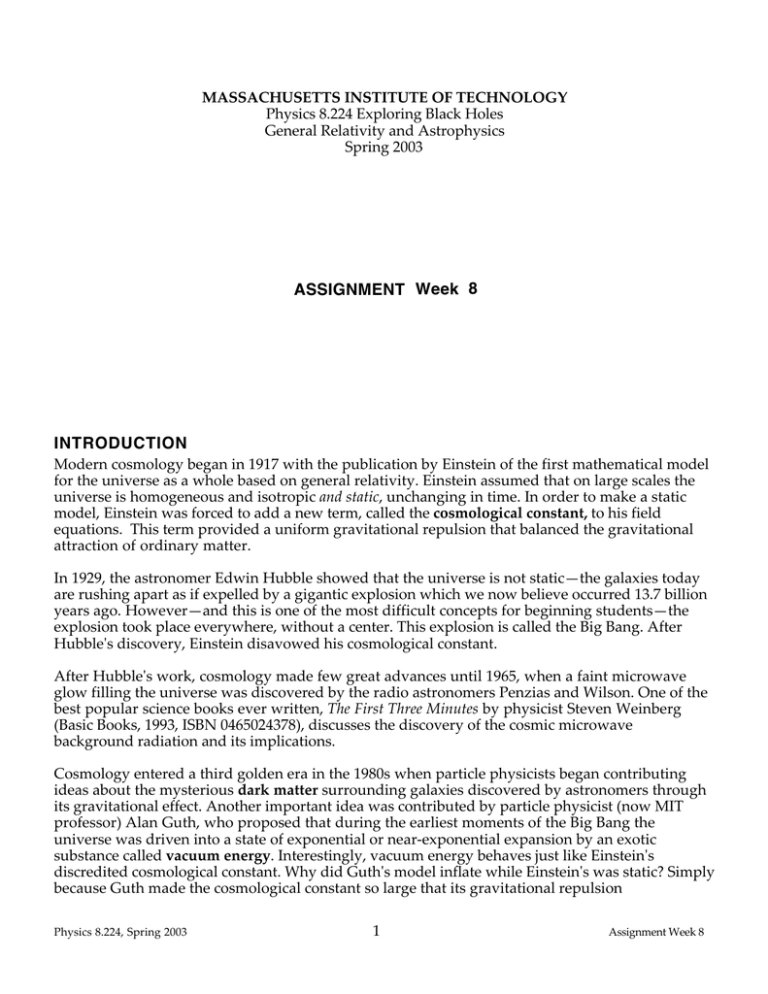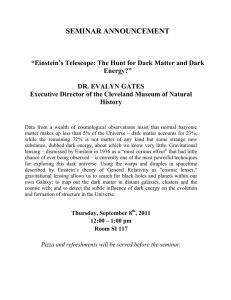ASSIGNMENT Week 8 INTRODUCTION
advertisement

MASSACHUSETTS INSTITUTE OF TECHNOLOGY Physics 8.224 Exploring Black Holes General Relativity and Astrophysics Spring 2003 ASSIGNMENT Week 8 INTRODUCTION Modern cosmology began in 1917 with the publication by Einstein of the first mathematical model for the universe as a whole based on general relativity. Einstein assumed that on large scales the universe is homogeneous and isotropic and static, unchanging in time. In order to make a static model, Einstein was forced to add a new term, called the cosmological constant, to his field equations. This term provided a uniform gravitational repulsion that balanced the gravitational attraction of ordinary matter. In 1929, the astronomer Edwin Hubble showed that the universe is not static—the galaxies today are rushing apart as if expelled by a gigantic explosion which we now believe occurred 13.7 billion years ago. However—and this is one of the most difficult concepts for beginning students—the explosion took place everywhere, without a center. This explosion is called the Big Bang. After Hubble's discovery, Einstein disavowed his cosmological constant. After Hubble's work, cosmology made few great advances until 1965, when a faint microwave glow filling the universe was discovered by the radio astronomers Penzias and Wilson. One of the best popular science books ever written, The First Three Minutes by physicist Steven Weinberg (Basic Books, 1993, ISBN 0465024378), discusses the discovery of the cosmic microwave background radiation and its implications. Cosmology entered a third golden era in the 1980s when particle physicists began contributing ideas about the mysterious dark matter surrounding galaxies discovered by astronomers through its gravitational effect. Another important idea was contributed by particle physicist (now MIT professor) Alan Guth, who proposed that during the earliest moments of the Big Bang the universe was driven into a state of exponential or near-exponential expansion by an exotic substance called vacuum energy. Interestingly, vacuum energy behaves just like Einstein's discredited cosmological constant. Why did Guth's model inflate while Einstein's was static? Simply because Guth made the cosmological constant so large that its gravitational repulsion Physics 8.224, Spring 2003 1 Assignment Week 8 overwhelmed the gravitational attraction of ordinary matter. However, Guth required that this repulsive gravitational substance would quickly decay away, leaving the universe spatially flat (K = 0) and in a state of rapid expansion that, 13.7 billion years later, has slowed down to the leisurely pace we see today. A fourth revolution in cosmology began in the mid-1990s, thanks to two crucial new observations. The first made in 1998 through the optical light from distance supernova explosions, suggests that the expansion of the universe is currently accelerating instead of decelerating as would be expected due to the gravitational attraction of matter. Once again, vacuum energy can explain this by its repulsive gravitational effect. Some astrophysicists still debate whether the interpretation of the supernova results is correct, but the great majority of cosmologists agree that the weight of evidence from many different clues supports the conclusion that vacuum energy (or a generalized substance called dark energy) drives the universe into a new phase of accelerated expansion. The second recent observation is the discovery and measurement of fluctuations in the cosmic microwave background radiation. The most recent measurements by the WMAP satellite indicates that these fluctuations fit the predictions of Guth's cosmic inflation theory. They are the seed fluctuations that changed the homogeneous and isotropic universe into a richly textured cosmos full of galaxies, stars, and planets. These observations are so recent that few books have been written about them. Moreover, Thorne's book excludes cosmology. Thus, in this last week of regular assignments, we provide an updated Cosmology project that replaces Project G in EBH. If you are interested in a very broad overview of modern cosmology ranging from black holes to the big bang and other universes, you may read a popular article entitled "Piecing Together the Biggest Puzzle of All" written by distinguished astrophysicist Martin Rees for Science magazine, volume 290 (2000), pages 1919-1925. The Rees article is available online at http://arXiv.org/abs/astro-ph/0103391 . It is optional for class. READINGS Cosmology by Bertschinger, Burgess, and Taylor, download this PDF file from the Assignments section of the class website. AND THORNE: Chapter 9 Serendipity Optional: "Piecing Together the Biggest Puzzle of All" by Martin Rees. See above. At least one of the following questions will be on the recitation quiz: 1. Explain BRIEFLY how radio astronomers create a radio antenna with resolving power comparable to that of a single dish many kilometers in diameter. 2. Radio signals often come from "lobes" that are far from the galaxy that is the source of the energy which they emit. Describe a physical mechanism that might result in radio emission from these lobes. 3. Make a physical argument that justifies the following variation of the density of different components of the universe as a function of the scale factor R Physics 8.224, Spring 2003 2 Assignment Week 8 density of matter goes as 1/R 3 4 density of radiation goes as 1/R density of dark energy is independent of R 4. When the Universe is twice as old as it is now, one of your descendents (who is living elsewhere than near our long-gone Sun!) looks at the heavens by eye. According to the cosmological model and current densities discussed in the cosmology project, what will he or she (or it) see? SEMINAR Dr.Jeffrey McClintock of the Harvard Smithsonian Astrophysical will speak on Black Holes in X-ray Binarie PROJECT By end of week #8 post on the website for your project an abstract and outline of your project. PROBLEM SET By end of week #8, submit answers to the following Queries from the Cosmology project. NOTE that you are asked to solve only parts of some Queries. A. QUERY 2. Measuring Distance. Solve all parts. B. QUERY 5. Contributions to the Density. Solve all parts C. QUERY 6. The Friedmann-Robertson-Walker Universe. Solve all parts. D. QUERY 7. Various Kinds of Universes. Solve parts A and C. E. QUERY 9. Acceleration of the Scale Factor. Solve all parts. F. QUERY 10. Pressure from Different Sources. Solve parts A, B, and C. G. QUERY 11. Acceleration of the Scale Factor of the Universe. Solve parts 1 thru 3. H. QUERY 12. Dark Matter from a Rotation Curve. Solve all parts. Physics 8.224, Spring 2003 3 Assignment Week 8


